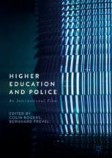Search
Search Results
-
Tree-Based Forecasting Methods
The past two chapters have provided the necessary technical background for a consideration of statistical procedures that can be especially effective...
-
Transparency, Accuracy and Fairness
Criminal justice risk assessments are often far more than academic exercises. They can serve as informational input to a range of real decisions...
-
Some Concluding Observations About Actuarial Justice and More
This chapter offers some brief thoughts about what the future may hold for the procedures that figure centrally in the book, and discusses...
-
A Conceptual Introduction to Classification and Forecasting
Because the criminal justice outcomes to be forecast are usually categorical (e.g., fail or not), this chapter considers crime forecasting as a...
-
Some Important Background Material
Criminal justice forecasts of risk are increasingly being associated with machine learning and artificial intelligence. One might get the impression...
-
A More Formal Treatment of Classification and Forecasting
This chapter covers much of the foundational material from the last chapter but more formally and in more detail. The chapter opens with a discussion...
-
Implementation
All of the material to this point would be at best academic if modern algorithmic risk forecasts were unable to inform practice. This chapter turns...
-
Getting Started
This chapter provides a general introduction to forecasting criminal behavior in criminal justice settings. A common application is to predict at a...
-
Real Applications
In order to help illustrate the ideas from previous chapters, this chapter provides detailed examples of criminal justice forecasting. These are real...
-
Behaviour Lists: Comparing Sequences of Violence and the Night-Time Economy
One of the main methods for conducting Behaviour Sequence Analysis (BSA) in academic research is using a behaviour list (a pre-designed list of...
-
Higher Police Education in the Netherlands
The Police Academy of the Netherlands was founded in 1992. Ten years later, a radical metamorphosis of police education has been enacted (Grotendorst...
-
Introduction: Higher Police Education—An International Perspective
When considering the future of policing one thing is certain. Policing does not exist in a vacuum. It is impacted upon daily and, in the long term,...
-
Police Higher Education in China
This chapter provides an overview of the development of police higher education in China since the founding of the People’s Republic of China (PRC)....
-
Online Behaviour Lists: Sexual Assaults and Rape Cases
Online behaviour lists are a time-effective way of conducting Behaviour Sequence Analysis (BSA) research. The current chapter outlines how to put BSA...
-
Whose Car?
Evidence provided to the police is often imperfect. Even witnesses who are quite sure of what they saw or heard may be wrong. How should their...
-
Information
Bayes’ Rule shows how we can use evidence to revise belief. Base rates describe what we know before evidence is available. These probabilities are...
-
Margin of Error
The Stockholm police were able to link Ingrid’s eyewitness evidence with the cars of the two suspects because they had likelihoods to help them do...
-
Track Record
Experimental results are one way of finding the relation between what people say and alternative accounts of why they said it. Likelihoods quantify...
-
Being Careful About Base Rates
We have seen that using a test for medical diagnosis requires that we distinguish two quite distinct sources of information: the characteristics of...
-
Diagnosis
The chapters in the previous section showed how Bayes’ Rule uses likelihoods to evaluate evidence and arrive at a justified belief in the alternative...
